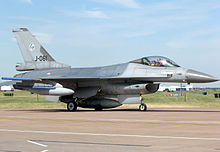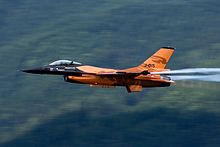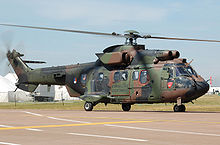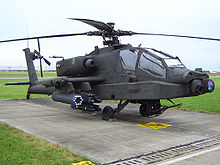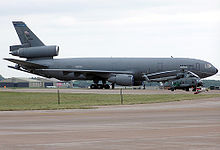- Royal Netherlands Air Force
-
Royal Netherlands Air Force
Koninklijke Luchtmacht (KLu)
Roundel of the Royal Netherlands Air ForceFounded 27 March 1953 Country  Netherlands
NetherlandsAllegiance The Netherlands / NATO / EUFOR Branch Air Force Size 8,000 personnel,[1] 217 aircraft Part of Dutch Armed Forces Motto Parvus numero, magnus merito (Latin: small in numbers, great in deeds) Commanders Current
commanderLuitenant-generaal J.H.M.P Jansen Aircraft flown Attack AH-64D Fighter F-16 Patrol Dornier 228 Trainer PC-7 Transport C-130 Hercules, CH-47 Chinook, AS-532 Cougar, NH-90, DC-10/KDC-10, Agusta-Bell 412, Gulfstream IV, Westland Lynx, Aérospatiale Alouette III The Royal Netherlands Air Force (RNLAF), Dutch Koninklijke Luchtmacht (KLu), is the military aviation branch of the Netherlands Armed Forces. Its ancestor, the Luchtvaartafdeling (aviation department) of the Dutch Army was founded on 1 July 1913, with four pilots. The aerobatic display team of the Royal Netherlands Air Force is the Solo Display Team.
Contents
History
The beginning in 1913
The Royal Netherlands Air Force (RNLAF) is the second youngest operational part of the Dutch Armed Forces, which consists of four parts: Navy, Army, Air Force and Military Police.
Dutch air power started in July 1913 with the founding of the Army Aviation Group (Luchtvaartafdeeling or LVA) at Soesterberg airfield (vliegbasis Soesterberg). When founded, the Army Aviation Group operated one aircraft, the Brik, which was supplemented with three French Farman aircraft a few months later.
These aircraft were soon outdated and the Dutch government ordered several fighter/reconnaissance Nieuport and Caudron aircraft to replace them.
1914-1918 WWI
The Netherlands maintained a neutral position during World War I and the Army Aviation Group did not take part in any action, instead developing the force's capabilities.
Pilot training was opened for ranks below officer, and technical, aerial photography, meteorological and navigation flights were established.
New airfields were established at Arnhem, Gilze-Rijen air base, Venlo and Vlissingen.
Between the wars
After the end of World War I the Dutch government cut the defence budget and the Army Aviation Group was almost dissolved. As political tensions in Europe increased during the late 1930s the government tried to rebuild the armed forces again in 1938 but there were many problems, not least the shortage of pilot instructors, navigators and pilots to fly the new multiple engine aircraft. Lack of standardisation and resulting maintenance issues added to the complexity of the rebuilding task.
World War II and late 1940s
As war loomed, in July 1939 the Army Aviation Group was renamed the Army Aviation Brigade (Luchtvaartbrigade).
In August 1939, the Netherlands government mobilised its armed forces, but due to limited budgets the Army Aviation Brigade operated only 176 combat aircraft of the following types:
- 16 Fokker T.V type bombers
- 36 Fokker D.XXI single-engine fighters
- 35 Fokker G.I twin-engine fighters
- 7 Fokker D.XVII single engine fighters
- 17 Douglas DB-8A-3N light bombers
- 20 Fokker C.X light bombers
- 33 Fokker C.V reconnaissance aircraft
- 20 Koolhoven FK-51 artillery observer aircraft
In May 1940, Germany invaded the Netherlands. Within five days the Dutch Army Aviation Brigade was taken out by the German Luftwaffe. All of the Brigade's bombers, along with 30 D.XXI and 17 G.I fighters were shot down; two D.XXI and eight G.I were destroyed on the ground. Two G.I were captured by German forces, one of which was later flown to England by a Fokker pilot. The Douglas bombers were used as fighters because no suitable bombs were available; these aircraft were poorly suited for this role and eight were shot down and three destroyed on the ground in the first hours of the conflict.
In spite of their numerical inferiority, the Dutch armed forces did enjoy success against the Luftwaffe, having 350 Luftwaffe aircraft destroyed, although many of these were lost to anti-aircraft fire and crashes at improvised landing fields in the Netherlands rather than due to action by Dutch fighters. The cost was high - almost 95% of the Dutch pilots were lost. In recognition of their actions Queen Wilhelmina granted the highest Dutch military decoration, the Militaire Willemsorde (MWO), to the Army Aviation Brigade collectively.
Some aircrews escaped to England and on June 1, 1940, 320 Squadron and 321 Squadron were established there under RAF operational command. Due to a shortage of personnel, 321 Squadron was absorbed by 320 Sqn in January 1941. Although their personnel were predominantly from the Navy Air Service, Army Aviation aircrew also served with 320 Sqn until the end of the war.
In 1941, the Royal Netherlands Military Flying School was re-established, in the United States at Jackson Field (also known as Hawkins Field), Jackson, Mississippi, operating lend-lease aircraft and training all military aircrew for the Netherlands.
The separate Militaire Luchtvaart van het Koninklijk Nederlands-Indisch Leger (ML-KNIL; Royal Netherlands East Indies Army Military Air Service) continued in the Netherlands East Indies (NEI), until its occupation by Japan in 1942.[2][3] Some personnel escaped to Australia and Ceylon. 321 Squadron was re-formed in Ceylon, in March 1942, from Dutch aviators.
In 1942, 18 (NEI) Squadron, a joint Dutch-Australian unit was established, in Canberra, equipped with B-25 Mitchell bombers. It saw action in the New Guinea campaign and over the Dutch East Indies. In 1943, 120 (NEI) Squadron was established. Equipped with Kittyhawk fighters, it flew many missions under Australian command, including the recapturing of Dutch New Guinea.
In June 1943, a Dutch fighter squadron was established in England. 322 (Dutch) Squadron, equipped with the Supermarine Spitfire, saw action as part of the RAF. 322 Sqn aircraft featured the British RAF roundels as well as the Dutch orange triangle. 322 Sqn was successfully deployed against incoming V-1 flying bombs. From mid-1944, during the invasion of Normandy, it executed ground attack missions over France and Belgium.
In July 1944, the Directorate of Netherlands Airpower was established in London.
In 1947, its Chief of Air Force Staff was appointed.
The 1950s and 1960s
In 1951 several non-combat functions in the Army Aviation were opened to women.
On the 27th of March 1953 the Royal Netherlands Air Force officially became part of the Dutch armed forces.
The Air Defense Command, (Commando Lucht Verdediging, abbreviated CLV) consisting of a command unit, five radar stations and six fighter squadrons, had been established. Its radar equipment as well as its air defense fighters all came from obsolete RAF stocks.
- The Spitfire Mk.IX was used by 322 sqn until 1954, but was replaced as new squadrons were established.
- The Gloster Meteor F Mk.IV was used by 322, 323, 324, 325, 326, 327 and 328 sqn from 1948-1957.
- The Gloster Meteor F Mk.VIII was used by 322, 323, 324, 325, 326, 327 and 328 sqn between 1950-1959.
After the Netherlands joined NATO another new command: Tactical Air Command (Commando Tactische Luchtstrijdkrachten, abbreviated CTL) was established.
- CTL consisted of seven new strike squadrons (306, 311, 312, 313, 314, 315 and 316 sqn), all equipped with Republic F-84G Thunderjet aircraft. These aircraft were supplied by the United States under the Mutual Defense Aid Program from 1952-1956.
- 306, 322, 323, 324, 325, 326 and 327 Sqn operated the Hawker Hunter F Mk4 between 1956–1964, and the Hawker Hunter F Mk.6 between 1957-1968.
- 700, 701 and 702 Sqn operated the F86 Sabre all-weather fighter between 1956–1964.
- 306, 311, 312, 313, 314, 315 and 316 sqn changed aircraft configuration from 1955-1970 as the Republic F-84F Thunderstreak and RF-84F Thunderflash became available.
New Guinea conflict
The Indonesian government claimed New Guinea following the end of the second world war. The Dutch government considered the area Dutch territory. Negotiations over the country were conducted for years, but tensions grew until Indonesia broke diplomatic relations with the Netherlands at the end of the 1950s.
In response, in 1958, the Netherlands deployed military reinforcements to New Guinea, including an Air Force detachment for the air defense of the island Biak as there was evidence that Indonesia was infiltrating the island in advance of a military operation.
The first Air Force contribution was the installation of two MkIV early warning radars on Biak and neighbouring Woendi island.
The political situation between the Netherlands and Indonesia continued to deteriorate and in 1960 the Dutch government deployed reinforcements. The operations were known by name as ’Plan Fidelio’. For the Dutch Air Force this meant the establishment of an Air Defense Command for New Guinea (Commando Luchtverdediging Nederlands Nieuw-Guinea - CLV NNG) consisting of :
- one Hawker Hunter Mk.4 air defence squadron;
- a radar navigation system at Biak, and;
- a reserve airstrip at Noemfoer.
The Dutch government deployed a squadron consisting of 12 Hawker Hunter Mk.4 AD fighters and two Alouette II SAR helicopters. They were transported to Southeast Asia by the Karel Doorman. One year later the Dutch government deployed another 12 Hawker Hunter Mk6 AD fighters; these aircraft carried more fuel and had a larger combat radius.
In August 1962 Indonesia was ready to attack New Guinea. Despite reinforcements the Dutch defences would be insufficient to withstand the coming attack. Therefore, and because of international political pressure the Dutch government was forced to agree to the peaceful surrender of New Guinea. Dutch forces were withdrawn from the territory.
The establishment of 336 transport squadron is closely connected to New Guinea. Soon after activation this unit was deployed to New Guinea to take over air transport from the Dutch Navy. 336 Sqn deployed and took over three Navy Dakotas and three US supplied aircraft. 336 Sqn operated from Mokmer airstrip and transported more than 5,400 passengers between September 1961 and September 1962.
The Cold War era, 1960s, 1970s and later
During the cold war era Dutch Air Force units played an important part in the West European defence against the opposing Warsaw Pact forces. The Dutch Air Force manned five fully operational self supporting Missile Groups in West Germany (1 and 2 MslGrp were equipped with NIKE batteries, while 3,4 and 5 MslGrp were equipped with Hawk). Dutch fighters and other weapon systems also took a full part in NATO alert, standby duties and exercises through the years.
- 306, 311, 312, 322 and 323 Sqn changed configuration again from 1962-1983 after the dual role F-104 Starfighter was introduced.
- 313, 314, 315 and 316 Sqn switched over to the NF-5 Freedom Fighter from 1969-1992. The NF-5 was a CF-5 fighter development. Some of the features on the NF-5 were later used by Northrop on the F-5E/F Tiger II variant.
- From 1979 until now all remaining RNLAF squadrons (306, 311, 312, 313, 315, 322 and 323) use NATO's standard fighter-bomber: the multi role F-16 Fighting Falcon.
Former Yugoslavia
RNLAF F-16s participated in all operations over Yugoslavia from 1993 Deny Flight, including Deliberate Force in 1995 and ending with Operation Allied Force in 1999 from two bases in Italy. Initially from Villafranca AB in the north of Italy, later moving south to Amendola AB. During the operations over FRY RNLAF F-16s flew reconnaissance (306Sqn detachments from Volkel AB were in theatre throughout the operations), enforced the Bosnian no-fly zone, dropped bombs on Udbina AB (1994), successfully dropped an unguided bomb on a moving Serb tank during the fall of Srebrenica (1995), and took part in Deliberate Force later in the summer of 1995.
Between 1994 and 1997 Dutch GCI personnel, along with Canadian GCI controllers, provided many hundreds of hours of fighter control and surveillance as integrated members of USAF/ANG Air Control Squadrons. During the Kosovo crisis a RNLAF F-16AM (mid-life update) damaged [1] a Yugoslavian MiG-29 with an AMRAAM, but the force was more recognized for its high bombing accuracy. Allied Force was also the operational debut for the upgraded F-16AM. Besides the CAP mission, offensive bombing and photo reconnaissance missions were flown. KDC-10 tankers refuelled allied fighter over the Adriatic Sea, and C-130 Hercules transports flew daily sorties from Eindhoven AB to logistically support the operation. In total, RNLAF aircraft flew 1,194 sorties during operation Allied Force, which is about 7.5% of the total 37.000 sorties flown.
Operation Enduring Freedom and NATO in Afghanistan
In October 2002 a tri-national detachment of 18 Dutch, Danish and Norwegian F-16 ground attack aircraft and one Dutch KDC-10 tanker deployed to Manas Air Base in Kyrgyzstan in support of ground forces in Afghanistan as part of Operation Enduring Freedom. The RNLAF returned to Manas AB in September 2004 with five F-16 and one KDC-10 in support of the presidential elections of Afghanistan. This time the aircraft flew under the NATO ISAF flag.
In February 2006 four Dutch F-16s were joined by four Royal Norwegian Air Force F-16s in a detachment known as the 1st Netherlands-Norwegian European Participating Forces Expeditionary Air Wing (1 NLD/NOR EEAW). This was a follow up of the participation with the Belgian Air Force.[2]
As part of the expanded NATO ISAF mission in southern Afghanistan in August 2006, the Royal Netherlands Air Force had six F-16 ground-attack aircraft, three CH-47D Chinook of 298 Sq stationed at Kandahar Airfield. Additionally, a detachement of five AH-64D Apache helicopters had been stationed of Tarin Kowt, Uruzgan province.
On August 31, 2006 a Royal Netherlands Air Force (Michael "Sofac" Donkervoort) pilot was killed when his plane crashed during a mission to support British ground troops in Helmand province.[3]
Structure of the Royal Netherlands Air Force
Main Operating Bases (MOBs)
- Leeuwarden Air Base
- 322nd Squadron F-16
- 323rd (TACTES) Squadron F-16 (TACTES = TACtical Training Evaluation Standardisation)
- 920th Maintenance Squadron
- 921st Logistics Squadron
- 922nd Support Squadron
- Volkel Air Base
- 311th Squadron F-16
- 312th Squadron F-16
- 313th Squadron F-16
- 900th Maintenance Squadron
- 901st Logistics Squadron
- 640th Squadron
- 601st Reserve Squadron
- 703rd USAF Munition Support Sqn.
Air Defense Group
- De Peel Air Base Guided Weapon Group De Peel
- 800 Squadron (Command and Control)
- 802 Squadron MIM-104 Patriot
- 803 Squadron MIM-104 Patriot
- 650 Support Squadron
- 602 Reserve Squadron (partial)
- 951 Maintenance and Logistics Support Sqn.
Tactical Air Operations Base
- Air Operations Control Station Nieuw Milligen
- 603rd Reserve Squadron
- 711th Squadron (Control And Reporting Centre (CRC) and Military Air Traffic Control Centre (MilATCC))
- 970th Support Squadron
In 2009 710 and 711 Sqn were merged into one Air Operations Sqn (711Sqn). The status of the base was changed to NATO status as an airmobile NATO Deployable Air control centre, Recognised air picture production centre, Sensor fusion post DARS radar unit became operational on the base in the same year.
Defence Helicopter Command
- Gilze-Rijen Air Base
- 298th Squadron CH-47 Chinook
- 299th Squadron (Training and Standards)
- 300th Squadron Eurocopter Cougar
- 300th Squadron Royal Flight Aérospatiale Alouette III
- 301st Squadron AH-64 Apache
- 670th Security Squadron
- 930th Maintenance Squadron
- 931st Support Squadron
- 932nd Logistics Squadron
- 604st Reserve Squadron (partial)
- Leeuwarden Air Base
- 303rd Squadron Agusta Bell AB 412SP (Search and Rescue)
- Maritime airfield De Kooij
- VSQ-7. Westland Lynx (Training and Standards, Search and Rescue)
- VSQ-860. Westland Lynx
- 990 Maintenance Squadron
- 991 Support Squadron
- Deelen Air Base
- 11 Luchtmobiele Brigade training site.
Designated as a military aviation site. Only fully operational when used for military helicopter exercises, otherwise staffed only by security personnel.
Air Transport Base
- Eindhoven Airport
- 334th Transport Squadron (KDC-10, DC-10, Gulfstream IV, Fokker 50)
- 336th Transport Squadron (C-130H-30, C-130H)
- 602nd Reserve Squadron (partial)
- 940th Maintenance Support Squadron
- 941st Miscellaneous Support Squadron
- NATO Movement Coordination Centre Europe
Common Support Base
- Woensdrecht Air Base
- Royal Netherlands Air Force Training Center (Koninklijke Militaire School Luchtmacht)
- 130th Squadron (Initial Military Training)
- 131st Squadron (Initial Military Flight Training) (PC-7)
- 132nd Squadron (Training and Doctrine, Management Training)
- 133rd Squadron (Training for Electronic and Technical specialists)
- Air Force Meteorological Group
- Defence Materiel Command/Air Force Logistics Center
- 960th Squadron Maintenance and Logistics Support Squadron
- 961st Support Squadron
- 604st Reserve Squadron (partial)
- Royal Netherlands Air Force Training Center (Koninklijke Militaire School Luchtmacht)
Miscellaneous units
-
- 600th Reserve Squadron (Training and Standards, Air Liaison Officers, Specialist Reserves)
Closed/former air bases
- Soesterberg Air Base
- Royal Netherlands Military Aviation Museum. A part of the base remains in use as a glider field. The former USAFE site will be in use by ground units. (Relocated from Kamp van Zeist to the former 298 and 300 Sqn hangaars, open in 2013)
- Twenthe Air Base also known as Enschede Airport Twente
- Ypenburg Air Base
Rank structure
This link shows the ranks in the Royal Netherlands Navy, Army, Air Force and Marechaussee (Militarised Police): Military ranks of the Dutch armed forces
Strength
Aircraft Origin Type In service[4] Notes Fighter Aircraft Lockheed Martin F-16AM/BM Fighting Falcon  Netherlands/
Netherlands/ United States
United StatesMultirole fighter aircraft 67 213 License-built by Fokker of which 36 were sold to Chile, 9 were sold to Jordan, 45 are kept in storage. F-35A Lightning II  United States
United StatesMultirole stealth strikefighter aircraft 0+2 2 units ordered as part of LRIP (Low-Rate-Initial-Production). To be delivered by 2011/2012. Trainers Pilatus PC-7 Turbo Trainer  Switzerland
SwitzerlandLight Training Aircraft 13 Painted yellow/red before, now black with 2 yellow markings Transporters Lockheed C-130H-30 Hercules  United States
United StatesMedium transport aircraft 4 2 ex-US Navy EC-130Q's were converted to C-130H for RNLAF by Marshall Aerospace. Upon completion of the contract the 2 C-130H-30s will be updated the same standard as the 2 short fuselage C-130Hs.[5] Fokker 50  Netherlands
NetherlandsLight utility aircraft 2 Used for utility transport and medical evacuation. Official already out of service, but still being used to remain airworthy. To be sold. McDonnell Douglas KDC-10  United States
United StatesWide body transport aircraft 2 Aerial refuelling and passenger/cargo transport. Gulfstream IV  United States
United StatesLight utility aircraft 1 VIP transport Dornier 228  Germany
GermanyCoastal patrol duties 2 Wearing civil registrations but with military (air force and navy) crews[6] Helicopters Aérospatiale SA316B Alouette III  France
FranceLight VIP helicopter 4 Only used for aerial photography and Royal/VIP flights[7] Agusta-Bell 412  Italy
ItalyLight SAR and utility helicopter 3 SAR role, supporting the RNLAF training area over Vlieland and the Wadden Sea. Will be disposed of under 2011 spending plans. [8] Boeing AH-64D Apache  United States
United StatesAttack helicopter 29 (30 were procured but 1 crashed in 2004). Dutch Apaches are AH-64D but without the AN/APG-78 Longbow radar. Equipped with the Apache Arrowhead sensor upgrade.[9] All are to be upgraded to the Block II standard.[10] Eurocopter AS 532U2 Cougar Mk2  France
FranceMedium utility helicopter 8 Mid-Life Update programme as of 2009. A total of 17 ordered, but 9 were put in storage as part of budget cuts. Boeing CH-47D/F Chinook  United States
United StatesHeavy lift helicopter 17 7 former Canadian Forces CH-47C were sold to the Dutch in 1991 and modernized to D standard.[11][12] 6 new CH-47D in 1995 for a total of 13. 6 CH-47Fs on order (4 new and 2 to replace losses) and options for 2 CH-47Fs[5] Westland Lynx  United Kingdom
United KingdomASW, SAR and MEDEVAC duties 21 Only 10 still operational thanks to life prolonging maintenance. This was necessary due to delivery delays of the NH-90. One is held by Libyan pro-Qadhafi forces after a failed attempt to rescue two people from Libya on February the 27th.) Wearing Koninklijke Marine titles but since July 4, 2008 they belong to the Defensie Helikopter Commando (DHC), or Defence Helicopter Command. NH Industries NH-90  European Union
European UnionNATO frigate helicopter 20 Deliveries will start in 2010. 12 NFH-90s for use aboard frigates and destroyers and 8 (+2 in option) Tactical NFH to replace 300 Sq Eurocopter AS 532U2 Cougar Mk2 The future
- 85 F-35A Lightning II are expected to replace the F-16 fleet, but owing to rising costs, the decision has yet to be made.
- 20 NH90 helicopters will replace the current Navy Lynx helicopters. The NH90 helicopters will be stationed at Gilze-Rijen (8 NH-90 Naval Transport version and SAR) and De Kooy (12 NFH-90 anti-submarine warfare).
The Netherlands was the first country to sign up for the Production Sustainment and Follow On Development (PSFD) Phase of the F-35 Lightning II aircraft.[4]
Through the NATO Strategic Airlift Capability, the RNLAF has access to three C-17s.
Replacement for the F-16
The Netherlands Air Force wants to replace its F-16 fleet in the next decade. Candidates for the replacement were the Dassault Rafale, Lockheed Martin's F-16 Block 52/60, the Eurofighter Typhoon, the Saab Gripen and Lockheed Martins F-35. In 2002 The Netherlands signed a MOU (Memoradum Of Understanding) to co-develop the F-35 as a 'Tier 2' Partner. That deal is worth around 800 million US dollars, advanced by the Dutch government on behalf of Dutch industries: After the demise of Fokker Aircraft, the government wanted to retain whatever aerospace industry it could.
The F-35 seemed to be the best replacement for the F-16. But Saab is now offering their latest aircraft, the Saab Gripen NG (Next Generation), to The Netherlands at a much lower price (including maintenance for its entire lifespan). The Netherlands did compare the Saab Gripen NG and the F-35 in early 2009 and the F-35 came out on top. Many sources and signs indicate that the F-35 will be the next fighter of the Royal Netherlands Air Force.[citation needed]
In early 2008, a decision was put before Parliament to buy two test aircraft for Dutch pilots to train in the US. But instead, in April 2009 it was decided to buy just one test aircraft and defer the final decision as to what to buy to 2011, after the elections. The new government announced plans to acquire the second test aircraft in April 2011 in order to remain with the test program, but a next government and Parliament will review the whole process again while opposition to the F-35 is growing ever stronger. Reasons for this are ever rising costs, uncertainty about the exact cost of the aircraft, slips in the schedule of delivery and thus uncertainty about delivery dates. Also, Dutch industries have been complaining about their offsets from the USA.[13]
See also
- No. 322 Squadron RAF
- Solo Display Team
- Royal Netherlands East Indies Army Air Force
References
- ^ "Strengths and Weaknesses of the Netherlands Armed Forces: A Strategic Survey". http://www.rand.org/pubs/technical_reports/TR690/.
- ^ Klemen, L. "Forgotten Campaign: The Dutch East Indies Campaign 1941-1942". http://www.dutcheastindies.webs.com/.
- ^ Broshot, James A. (1999-2000). "Dutch Air Force Order of Battle in the Dutch East Indies, 30 November 1941". Forgotten Campaign: The Dutch East Indies Campaign 1941-1942. http://www.dutcheastindies.webs.com/Dutch_OOB.html.
- ^ "World Military Aircraft Inventory", Aerospace Source Book 2007, Aviation Week & Space Technology, January 15, 2007.
- ^ a b Dutch military aviation OrBat
- ^ Dutch Coastguard
- ^ Koninklijke Luchtmacht (Materieel - Helikopters)
- ^ Koninklijke Luchtmacht (Main - Materieel - Helikopters)
- ^ "Lockheed Martin Installs First Arrowhead MTADS/PNVS Systems on Netherlands' AH-64D Apaches" 10 October 2007
- ^ "The Netherlands – Upgrade AH-64D Apache Block I Helicopters to Block II" 12 August 2009
- ^ Former CH-147C
- ^ Boeing CH-147 CHINOOK
- ^ Uitgelachen PvdA boekt toch winst - Nieuws - TROUW
External links
- Official website
- Royal Netherlands Air Force
- Military Flags
- Squadron roundels
- Parliament Chamber Notes on buying C-130 and selling F-60 aircraft (Dutch)
- The Defense Security Cooperation Agency notified Congress of a possible sale to the Netherlands of CH-47F Chinook cargo helicopters (English)
under the command of the Ministry of Defence Air forces in Europe Sovereign
states- Albania
- Andorra
- Armenia
- Austria
- Azerbaijan
- Belarus
- Belgium
- Bosnia and Herzegovina
- Bulgaria
- Croatia
- Cyprus
- Czech Republic
- Denmark
- Estonia
- Finland
- France
- Georgia
- Germany
- Greece
- Hungary
- Iceland
- Ireland
- Italy
- Kazakhstan
- Latvia
- Liechtenstein
- Lithuania
- Luxembourg
- Macedonia
- Malta
- Moldova
- Monaco
- Montenegro
- Netherlands
- Norway
- Poland
- Portugal
- Romania
- Russia
- San Marino
- Serbia
- Slovakia
- Slovenia
- Spain
- Sweden
- Switzerland
- Turkey
- Ukraine
- United Kingdom
- Vatican City
States with limited
recognition- Abkhazia
- Kosovo
- Nagorno-Karabakh Republic
- Northern Cyprus
- South Ossetia
- Transnistria
Categories:- Military of the Netherlands
- Royal Netherlands Air Force
- Military units and formations established in 1913
- 1913 establishments in the Netherlands
Wikimedia Foundation. 2010.








